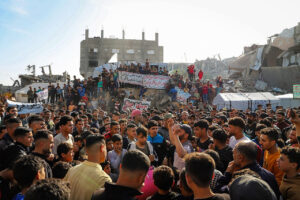The Gaza demonstrations and the desire for certainty

Palestinians take part in a protest calling for the end of the war and of Hamas’ rule in Gaza, Beit Lahiya, northern Gaza, 26 March 2025
Abdaljawad Omar writes in Mondoweiss on 27 March 2025:
On March 18th, Israeli warplanes resumed their ferocious bombardment of Gaza—killing more than 800 Palestinians in a matter of days. After nine days of the renewed assault on Gaza, protesters in Beit Lahia took to the streets. Holding signs that read “No to genocide,” some among them also directed blame at Palestinian armed factions, particularly Hamas. In Israeli media, this footage was instantly seized upon and repackaged: proof, it claimed, that Israel’s campaign was working, driving a wedge between the population and resistance groups. This image of Palestinian protest—fragmented, desperate, and ambiguously positioned—has become central to Israel’s war strategy. It sustains a dual narrative: that military onslaught is necessary, and that Palestinians themselves have come to recognize the violence as of their own making. The war in Gaza is no longer only a campaign of destruction; it is a psychological operation, aimed at producing the image of surrender, of Palestinians claiming responsibility for their death.
This image also serves another function: it legitimizes Israel’s internal consolidation of power. The headlines in Israel now speak of a government reconfiguring itself, pursuing a dual strategy—the reordering of its institutional architecture and the continuation of its perpetual war. These aims are not distinct; each sustains the other. The genocidal campaign in Gaza is not merely a military exercise—it presents the possibility of ethnic cleansing, ensures a volatile regional environment, and opens the space for confrontation with Iran. Internally, the right-wing project—marked by judicial overhauls and the redrawing of civic boundaries—rests on the maintenance of emergency. The war, in turn, is rationalized by the need for national cohesion, a narrative of unity forged under siege, and signs of Palestinian capitulation only serve this larger right-wing narrative. Together, these dynamics form a closed loop: self-reinforcing and mutually dependent. Today, these are the headlines in Israel: the dismissal of Shin Bet head Ronen Bar (not in effect yet), the firing of the State Attorney General (not in effect yet), and the passing of a judicial overhaul bill set to take effect in the next Knesset. All happening while Israel is supposedly engaged in war of expansion in Syria and Lebanon, a war of decisive end of the Palestinian question, a war of enunciating itself as the only hegemon in the Middle East. A coup at home, and endless war.
And yet, even these protests—frail and fractured though they are—do not recover the figure of innocence in the Israeli imagination. The demonstrators in Beit Lahia who call for an end to the war, who cry out against genocide and Hamas, are not received as voices from outside the domain of guilt, of people yearning for life without the threat of death. Their appearance does not interrupt the narrative of Palestinian collective culpability that Israel carefully curated during this war; instead, it recodes it. In Israeli discourse, they are framed not as victims but as potential collaborators—Palestinians willing to betray their own, to confess the error of resistance, to kneel before power.
